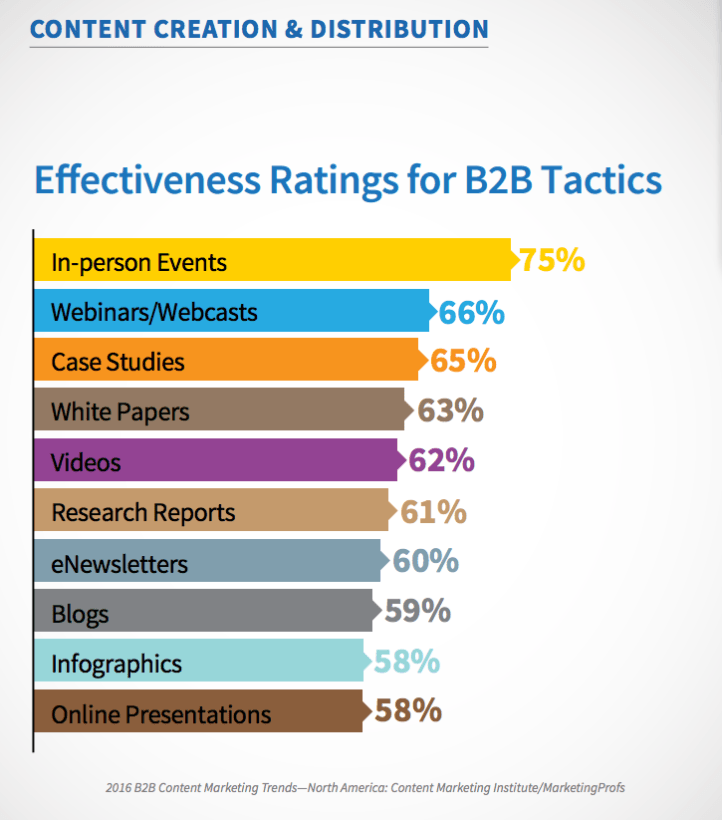
Thought leaders command respect, and becoming one is the dream of most people and organizations today. When you become an industry thought leader, expansion (even in sales) usually follows organically.
In fact, a study on business buying behavior by CEB — according to Forbes Insights — reveals that high-value customers are increasingly demanding education and advice as part of sales experience.
So where does white papers come in here? A white paper is a persuasive, in-depth report (or account) on an issue that the stakeholders of an industry are looking to understand. And here’s how you can harness it to become a thought leader:
Address a nagging problem that affects an entire industry
One potent way to build thought leadership is to create a white paper that thoroughly explains a problem that has been a nagging pain in an industry for a while and recommends a reliable and workable solution.
Piracy, for example, has been a long time nagging problem for folks in the film industry. In fact, according The Wall Street Journal, antipiracy and security firm Irdeto found a whopping 5.4 billion instances of online pirated movies, TV shows and even video games in 2009.
On top of that, US film distributor Kathy Wolfe, founder of Wolfe Video, also reported that she lost over $3 million in revenue in 2012 due to piracy. Isn’t this a problem that’s enough catch everyone’s attention in an industry? Wouldn’t a paper on this sort of problem and how it can be solved effectively be a goldmine?

However, to earn the best return on your investment, the problem you’re addressing in the white paper should be one that your company solves with its offerings. In other words, if you’re going to create a white paper on this piracy issue, for instance, your company should be selling an offering that solves piracy.
The idea about this is that once readers have learnt about the solution to an irksome problem that has been afflicting virtually everyone in their industry, they get to see the white paper sponsor or author as the “hero” who takes the nagging problem away.
Let me borrow a quote from Richard Waters of Go Assist here:
You cannot go wrong providing solutions to the problems that are holding people back from progressing.
Write about what your audience should be focusing on to grow
Apart from nagging problems, you can also use white papers to keep your audience in the know of the things they should be focusing on to grow. This demonstrates how much you care about solving their problems, and they get to see that.
In a recent case study, Cynthia Burkhardt – Head of Global Talent Acquisition at Philips – shared that one significant reason why she sees CEB as a leader in the tech industry is that they keep her in the loop of the next things she should be focusing on to enhance her work.

Fresh strategies that can enhance your customers’ business efforts, new technology they should be using and so on. All these are topics you can create in-depth reports on. As you do this, it becomes natural for your customers to seek your resources out whenever they need answers to even their biggest questions.
John Rampton, founder of Due.com, mirrors the same idea:
Content can be created in one of two ways: either with the primary mindset of attracting visitors, links and shares (and ultimately, sales), or from the mindset of helping. To truly help, your content needs to meet the needs, interests and pain points of your audience.
Steer clear of hyperboles and make claims based on concrete research
People don’t just run head over heels to believe the claims that you put in a white paper because it’s a well designed content with at least six or seven pages.
If you’re claiming that senior finance execs take payback periods more seriously than the initial capital invested in any given project, what’s your proof? Do you have any stats or survey to back that assertion up?

If your answer is ‘no’, you’ve made nothing but a hype, which keeps customers and prospects wondering why you really made that assertion in the first place — was it because you wanted to sell something, gain followers, or what exactly?
And according to AdAge:
60 percent of survey respondents claimed they turn down content that sounds like a sales pitch. Instead, three-fourths of respondents said they look to content for insights or ideas related to business.
Conclude with a clear, precise call to action
Yes, I know, a white paper isn’t meant to be a sales pitch, brochure and all that. But remember — you want to build an audience, a tribe that will almost always come perusing your “Resources” page when they need answers to their questions. Hence, you want to make sure you give them a precise and clear next step to take after reading your report.
Don’t direct them to your homepage. Shai Aharony, MD at Reboot Online says:
By now, you know your homepage has multiple options that can easily make them unsure about what to do. So you want to direct them to a specific page where they get to choose to become a member of your clan.
Also, you don’t have to ask for their emails again, since they’d have had to submit those before downloading your white paper. So instead, here are a few options you can give them:
- Check out our product that can solve the problem addressed in our white paper
- Like us on Facebook and be the first to get our next resources as they get published
- And so forth
In a nutshell
B2B organizations, according to Content Marketing Institute’s 2016’s B2B Content Marketing Report, have ranked white papers as the fourth most effective type of content in B2B marketing today.

Get the TNW newsletter
Get the most important tech news in your inbox each week.




